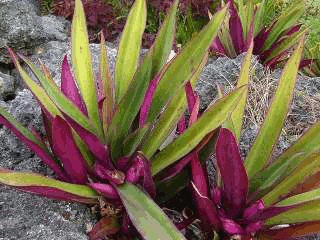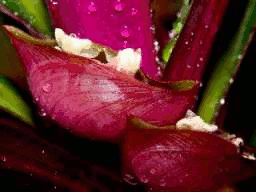Oyster Herb
Common Names: Oyster herb, maguey, daun kepah, nanas kerang, boatlily, Moses in a basket, cradle lily, Moses in his cradle, Moses on a raft, Moses in the bulrushes, men in a boat, moses-in-cradle.
Scientific Name: Tradescantia spathacea, Tradescantia discolor, Rhoeo spathacea
Climate: Warm and hot.
Plant Description: Herbaceous perennial plant with a short stem 30-45 cm high, from which several spliced leaves emerge. The leaves are long, semi-hard, sword-shaped. They are dark green at the top and violet or purple at the reverse. The inflorescence consists of a pair of axillary purple bracts, shaped like a ship that contains several flowers inside. The flowers are purple and white with 3 small petals.
Native to Mexico and Central America.
Cultivation: The perfect temperature for growing purple maguey is between 16°C and 21°C. But it can survive up to 7°C. It grows in full sun or in partial shade. It prefers well-drained soil and will grow well on rocks. Although it likes soil with substantial organic matter, the oyster will grow in sand or even coral rock. It is resistant to drought.
It can be propagated by seeds, cuttings or division.
The seeds can be sown outdoors in the fall or early spring. Plant seeds 30 cm apart. The seeds should be lightly covered once sown. Ideally, the soil in which they grow will be moist, rich, well drained, and acidic (pH 5 to 6). Seedlings grow best in partially shaded areas, but will tolerate sunny areas as long as the soil is kept moist.
To propagate by cuttings - in early spring the upper part of the plant is cut. This encourages the plant to produce side shoots. The side shoots are cut after they reach 5 to 10 cm. The cuttings are planted in fertilized, well-drained soil. To create the right medium, mix equal parts of standard soil, leaf mold, and sand. Cover the cuttings with plastic or glass and place them in a warm but shady place. After about two months, new shoots should appear. During the growing season fertilize every 2 weeks with compost mixed with water.
To propagate by division - remove clumps of the stems that contain part of the root system. Transplant them to a potting mix as you would for any rooted cut.
During general maintenance let the soil dry between waterings, especially during the winter months. Avoid prolonged exposure of roots to soil moisture. Cutting once they have flowered will create a second bloom in the fall. To maintain vigorous growth, plants must be divided every three years. Cut the dead foliage that appears during the life of the plant.
To harvest, cut the leaves from the base.
Note: Oyster Herb can create a dense ground cover that prevents plants around from germinating on the forest floor.
Uses: Traditionally it has been used as medicine.
Oyster Herb has traditionally been used in southern Mexico to prevent or treat infectious diseases, cancer, gangrene, varicose veins, to wash wounds, to treat coughs, and asthma. It is used to treat menstruation bleeds that last more than 10 days. Both dry and fresh leaves are being used in infusions. An infusion with fresh leaves is best after 24-30 days, but can also be taken after a few hours. To take care of the wounds, wash them three times a day or until the affected area heals with the water from boiled leaves. In the region of Tabasco, Mexico oyster herb it is used as a disinfectant, as anti-inflammatory and agent against tetanus. Crushed leaves are used to correct and settle the womb of the women in labor. Headache is treated by applying to the head the crushed leaves, smeared with vaporub. Juice made from the leaves with honey is being used for kidney pain, and dosed for a month. It is also used to relieve internal inflammation caused by blows.
Pests and Diseases: In general it is a plant resistant to pests and diseases. But if there is too much moisture, it can cause fungus.
References:
1. ttp://www.plantasymascotas.com/maguey-morado-rhoeo-discolor.html
2. https://www.gardenershq.com/Tradescantia-Spiderwort.php
3. http://www.medicinatradicionalmexicana.unam.mx/monografia.php?l=3&t=&id=7820
En Espanol: Maguey Morado
